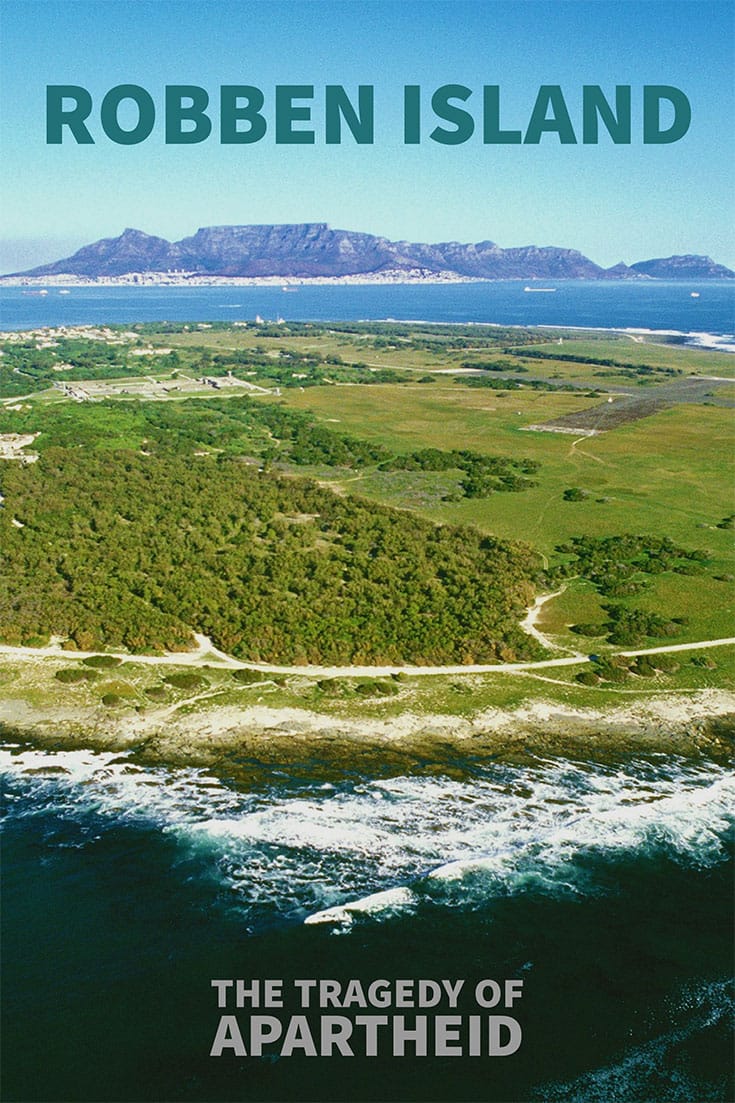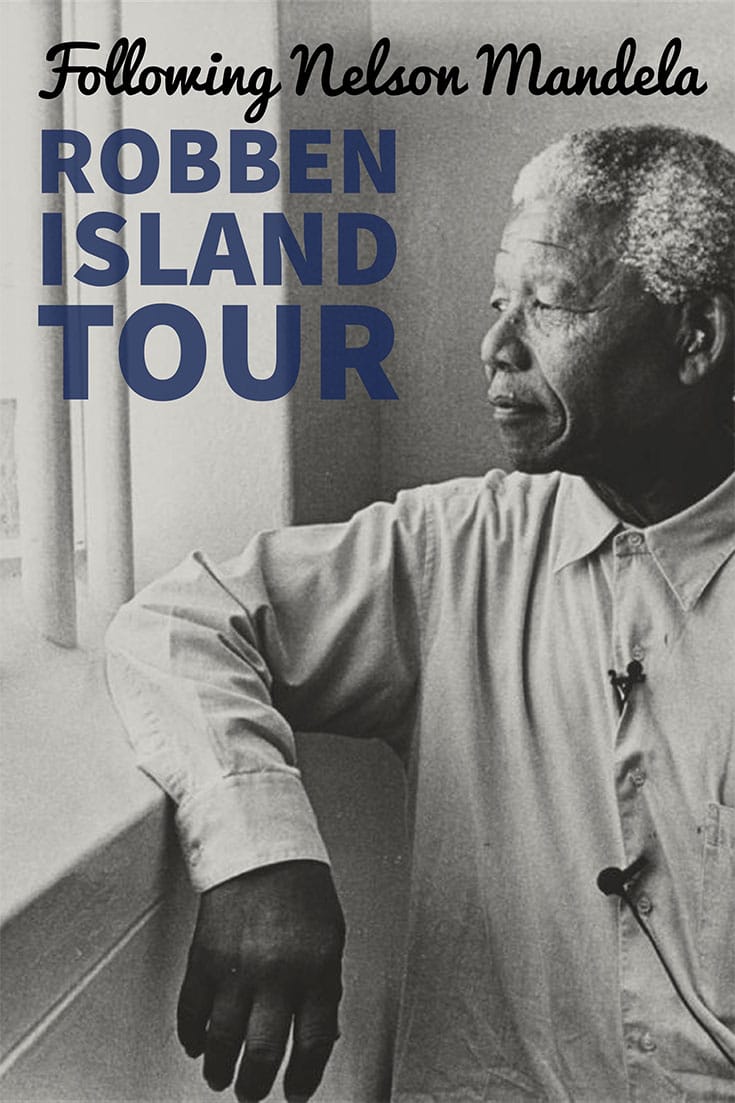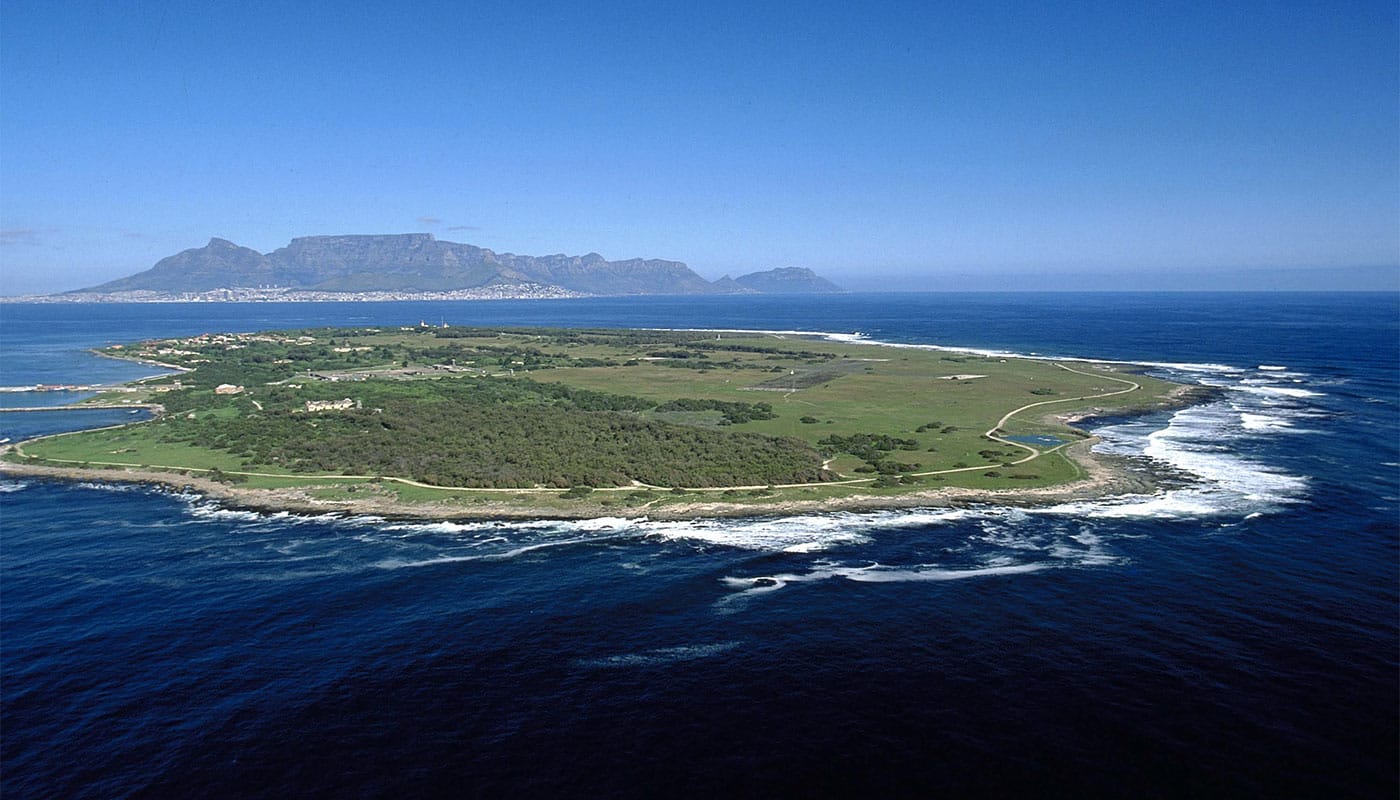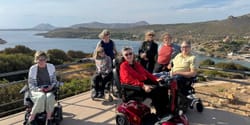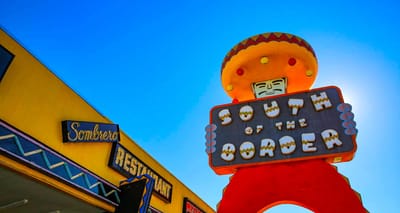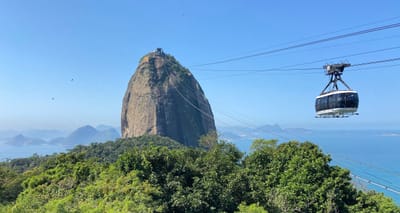Robben Island, located less than 10 kilometers off the coast of Cape Town, South Africa, was the site of a prison for political dissidents and criminals during the time of Apartheid. Its most famous inmate was Nelson Mandela, who later became President of South Africa and a Nobel Peace Prize Laureate, after spending 18 years in a small jail cell on the island. Designated in 1999 as a UNESCO World Heritage Site, Robben Island is now one of the most popular tourist attractions in all of South Africa.
The boat ride to and tour of the island are both wheelchair accessible. In this article, I’d like to share a bit more about Nelson Mandela and the island’s history, before commenting on the accessibility of the tour experience.
The Tragedy of Robben Island
From the 17th century, Robben Island was used as a place of detention for primarily political prisoners. In the 19th century, a leper colony was moved to the island from the mainland. And, in 1961, the South African government established its own prison that housed both political dissidents and violent criminals. It was during this period that the exclusion and separation which had so long been practiced on the island became the most tragic.
That tragedy is apparent in the story of Nelson Mandela, who spent his young adult life as an activist, outspoken critic of apartheid and thought leader.
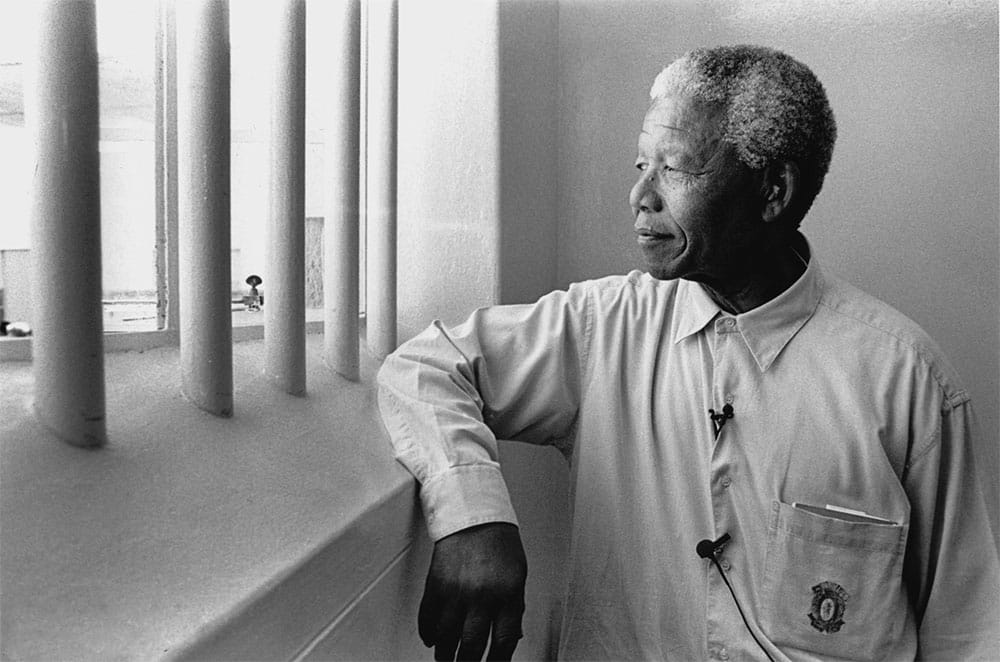
In 1962, Mandela was arrested and put on trial for encouraging workers to strike. He was found guilty and sentenced to a prison term of five years. The following year, while serving his prison sentence, he was placed on trial once again for his connections to a resistance group known as MK, or “Spear of the Nation.” Accused of planning to incite a guerrilla uprising against the government, which he denied, Mandela was found guilty and received a lifetime sentence.
Mandela’s relationship with Robben Island began in 1964, when he was transferred there from a prison in Pretoria, the nation’s capital city. He would be held there for 18 years, until 1982. Mandela became, unsurprisingly, a leader among the prisoners. He organized strikes to protest the poor treatment of prisoners, educated his peers through a secret “university” and studied law through a correspondence course with the University of London.
I could write a book about Nelson Mandela and his time at Robben Island, but in the interest of brevity (this is only a blog post), I will instead suggest that you purchase his autobiography, Long Walk to Freedom. It is a classic and should be read by anyone interested in the history of civil rights and human equality.
Rising up from History
In conducting research for this article, I encountered a powerful quote of Mandela’s that I feel obligated to share, especially to this audience.
For to be free is not merely to cast off one’s chains, but to live in a way that respects and enhances the freedom of others.
What Nelson Mandela said is important, so read it twice over. You see, freedom fighters—true heroes—are never satisfied only with the fulfillment of their personal interests. As South Africa’s first black president, Mandela worked hard to bring about racial reconciliation, foster forgiveness and promote unity in a post-apartheid era.
That pursuit of the greater good and equality for all people—whites included—is not what one might have expected from a man who had been imprisoned for 27 years. But, Nelson Mandela was no ordinary man. He was a giant, deserving of respect and admiration, and a man who served as an example for both his countrymen and people around the world.
Tickets & Cost
Tours of Robben Island often sell out days in advance, so it is important to reserve tickets early. You can purchase tickets in-person at The Nelson Mandela Gateway to Robben Island Museum at the V&A Waterfront, or purchase them online at www.robben-island.org.za.
Adult tickets cost 340 ZAR each (~$26 USD) and include round-trip ferry transportation to the island, a bus tour and access to the prison where Nelson Mandela was held. Tours depart at 9:00 a.m., 11:00 a.m. and 1:00 p.m. every day, and last approximately 3.5 hours. The boat ride is 30-45 minutes in each direction, depending on the seas and traffic in the harbor.
Boat Ride to Robben Island
Several different boats are used to transport visitors to the island, but it is the Sea Princess that is used to accommodate wheelchair users. A large catamaran, Sea Princess is able to carry more than 100 passengers.
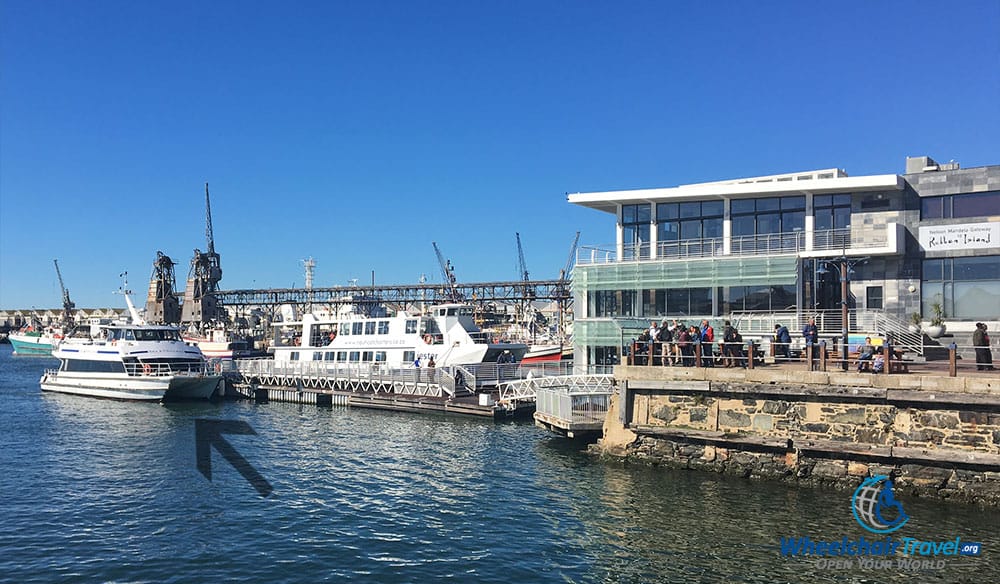
The docks on the mainland (V&A Waterfront) and on Robben Island are wheelchair accessible, via ramps. The ramps are steep, but dock personnel made sure to brace my wheelchair on the way down. Ramps are used to bridge the gap between the dock and boat, providing for an accessible and safe boarding experience.
Unfortunately, the design of Sea Princess means that the ship’s upper deck and the interior passenger cabin on the lower deck are not wheelchair accessible. Wheelchair users will need to stay out on the exposed deck at the stern of the ship, pictured below.
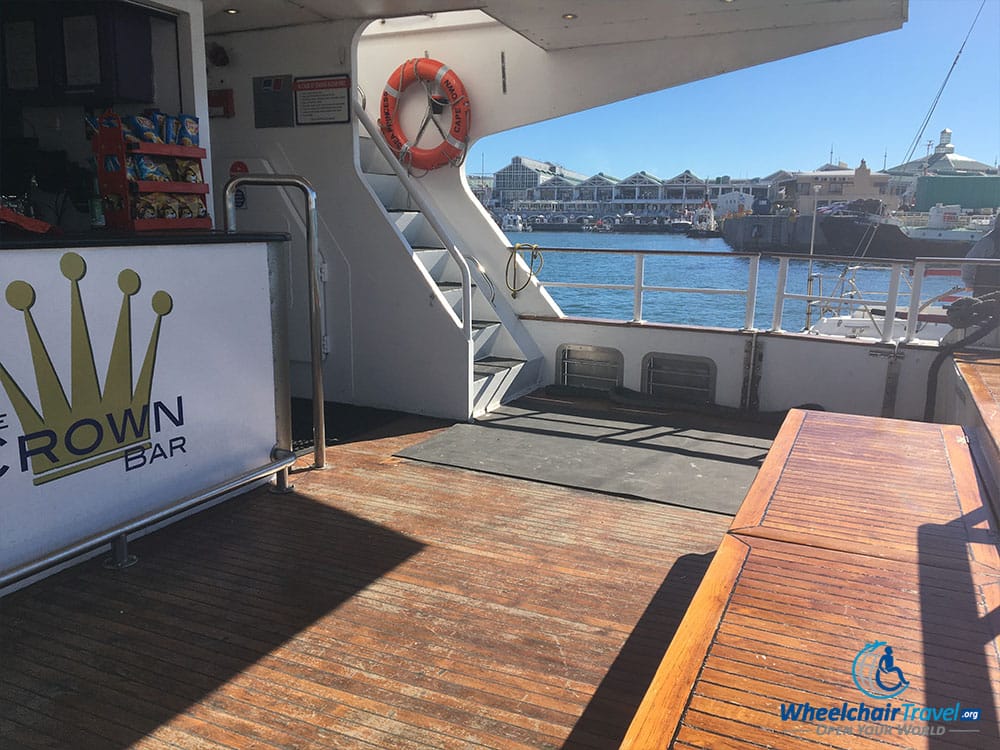
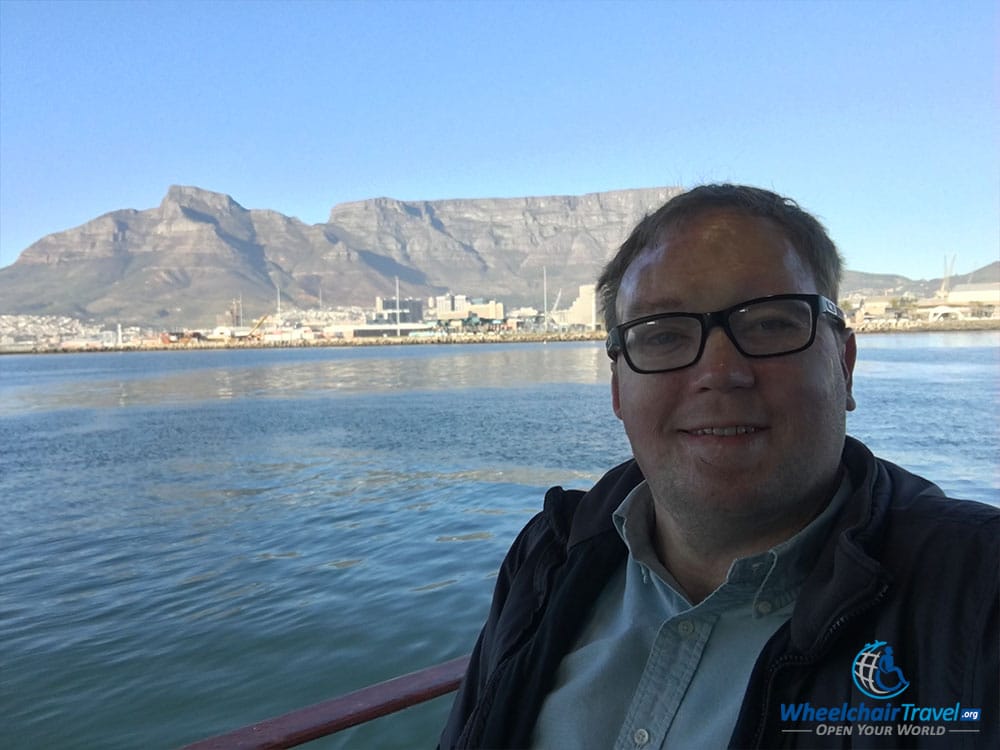
The deck at the rear of the ship is fairly large, and you’ll be free to park your wheelchair wherever you feel most comfortable. I never felt in any danger out there, and many other passengers came outside to admire the view of Table Mountain during the journey. I even posed for a selfie, with the mountain in the background.
A snack bar, accessible from this area, served pretzels, chips and drinks for a reasonable fee. Alcoholic beverages are only available for purchase on the return journey to Cape Town – you’ll have to stick to juice or soda on the way to Robben Island.
Bus Ride Around the Island
Once you’ve arrived to Robben Island, you’ll walk a short distance (around 200 yards) from the dock, through the historic entrance gate and to the tour buses.

“Ons Dien Met Trots,” the gate reads, which translates to “We Serve With Pride.” This welcome message, seemingly a lie about the prisoners who were held within, is peculiar at best. I couldn’t help thinking about another message I had seen, “Arbeit Macht Frei,” at the Nazi concentration camps. “Work Sets You Free” was another lie, even if it was more sinister in nature.
Just beyond the gate are the buses that will take you on an hour-long drive around the island. You’ll have one opportunity to alight for a bathroom break about 25-30 minutes into the bus tour.
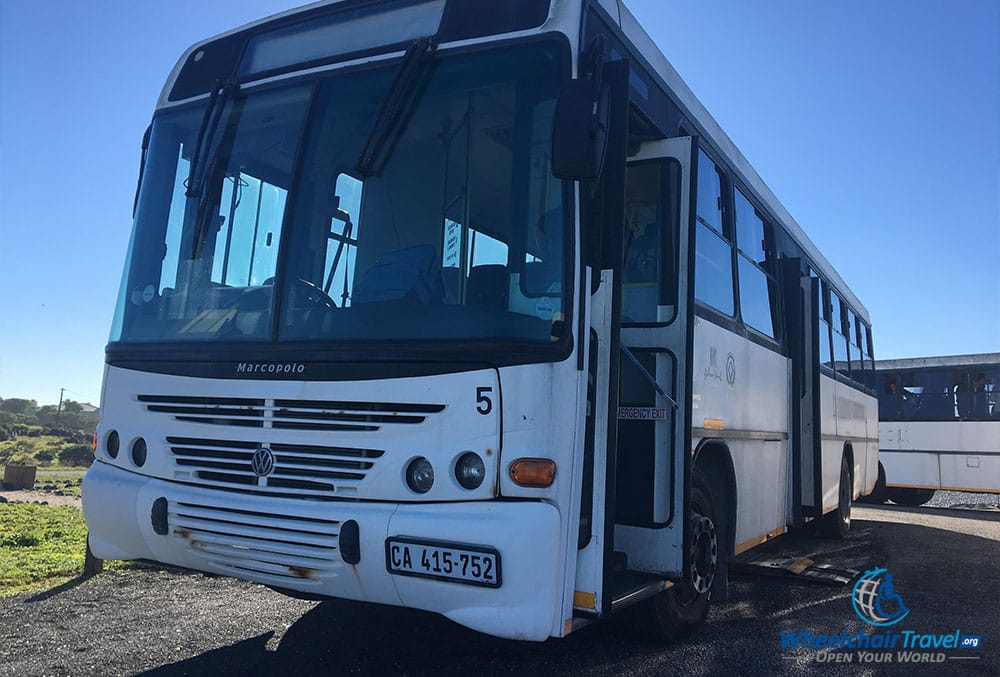
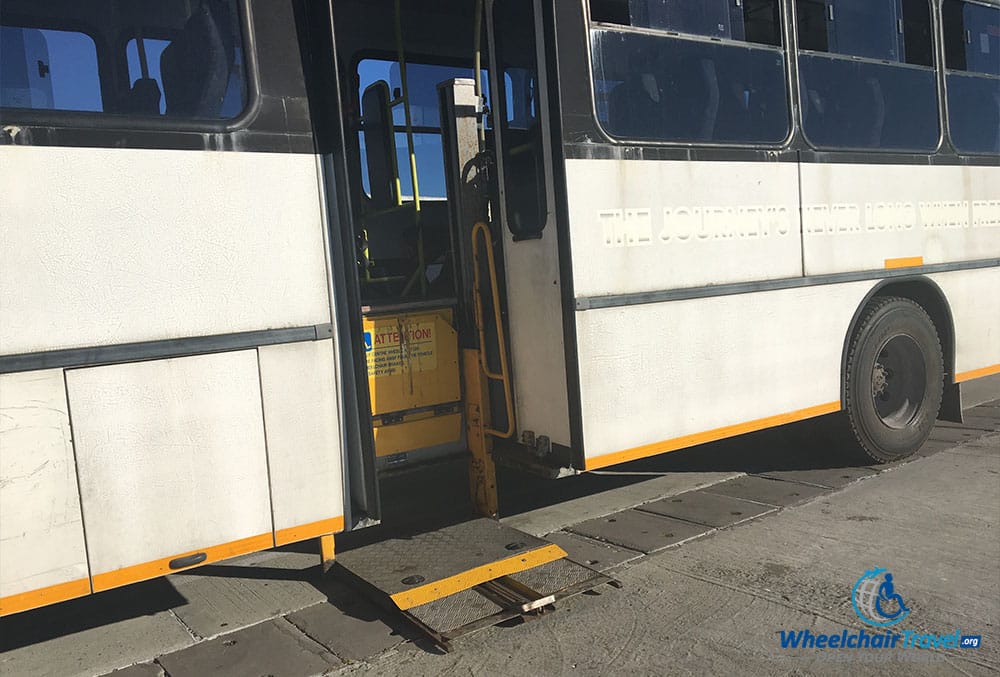
The high-floor buses are dated, but do have a wheelchair lift at the center boarding door. Although the lift platform looks small, it was able to accommodate my fully-loaded Quantum Q6 Edge 2.0 power wheelchair, which weighs close to 400 pounds. Once onboard, there is a dedicated wheelchair space on the right side of the bus. There are no securement straps, but the bus drives slowly and on paved roadways.
The bus was not equipped with air conditioning, but temperatures were lovely in July, the winter season in South Africa.
A tour guide will accompany you on the bus, speaking over the PA system about the island’s history and development. You’ll pass some of the oldest structures on the island and learn about their history and purpose.
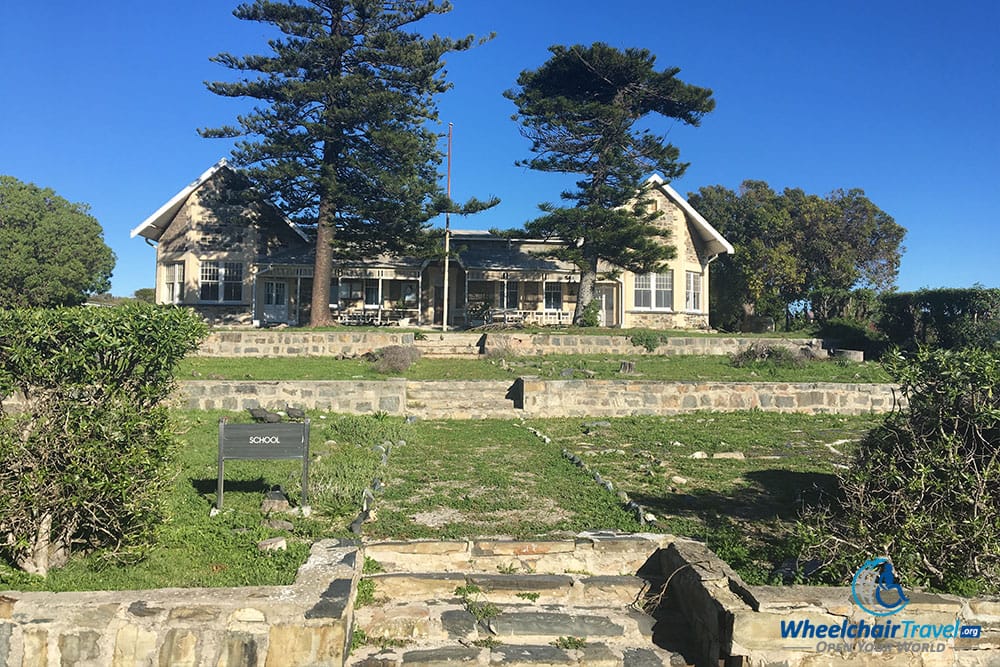
The building pictured above was a former schoolhouse for the prison guards’ children. Today, employees still live on the island, but their children attend school in Cape Town, riding a boat to and from the mainland each day.
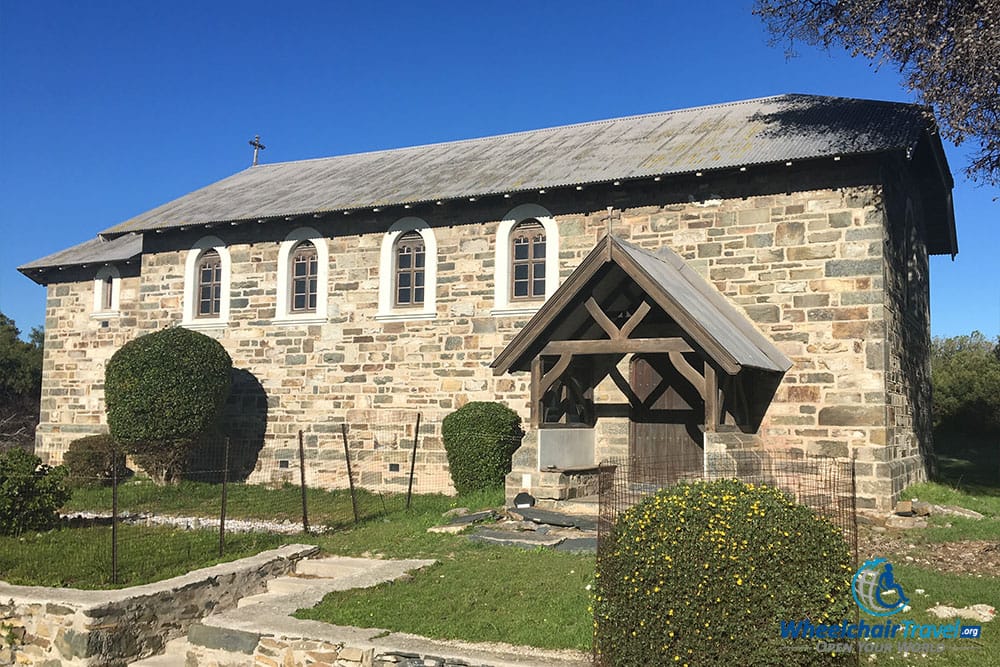
From 1845, people infected with leprosy were moved from the mainland to Robben Island. The Church of the Good Shepherd, an Anglican house of worship, was built by and served the lepers living on the island. Hundreds of lepers, perhaps up to a thousand, lived on the island at varying points. In 1931, they were relocated from the island back to the mainland, and their buildings were burned to the ground. This church was saved, but was abandoned and avoided by the island’s inhabitants for fear of infection.
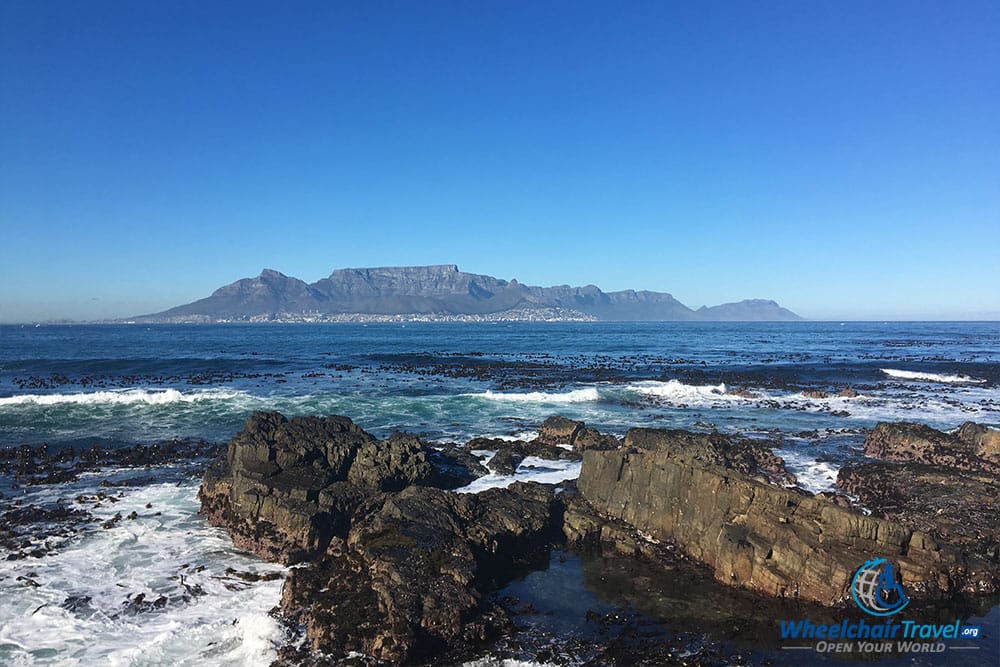
About 25 to 30 minutes into the tour, the bus will stop at the island’s southern tip, where you’ll have a great photo opportunity of the rocky coastline and Table Mountain in the distance. Wheelchair accessible bathroom facilities and a snack bar selling light snacks and non-alcoholic beverages are also located here.
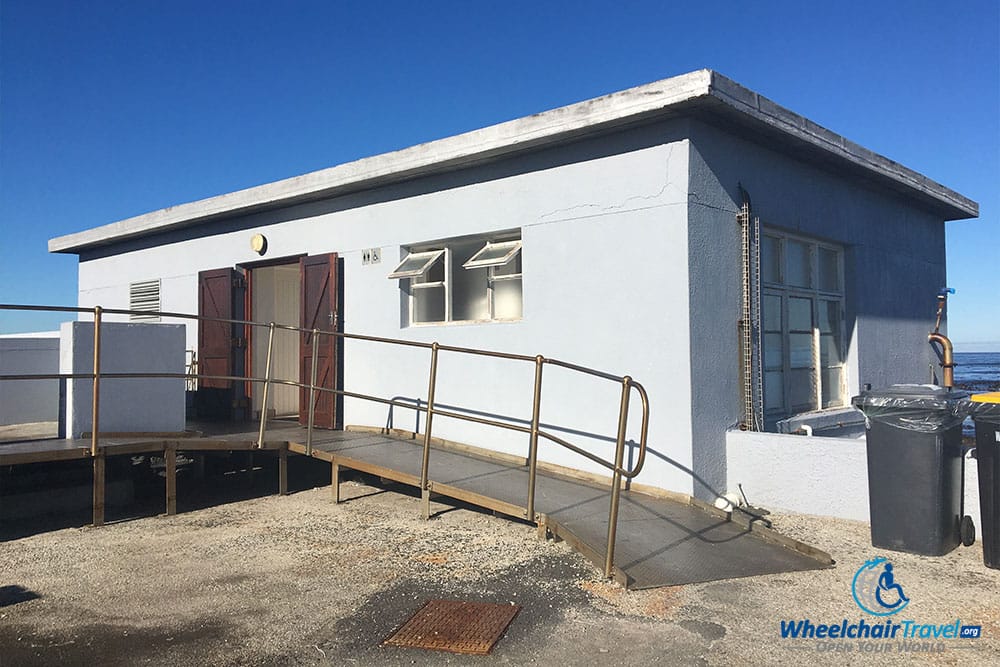
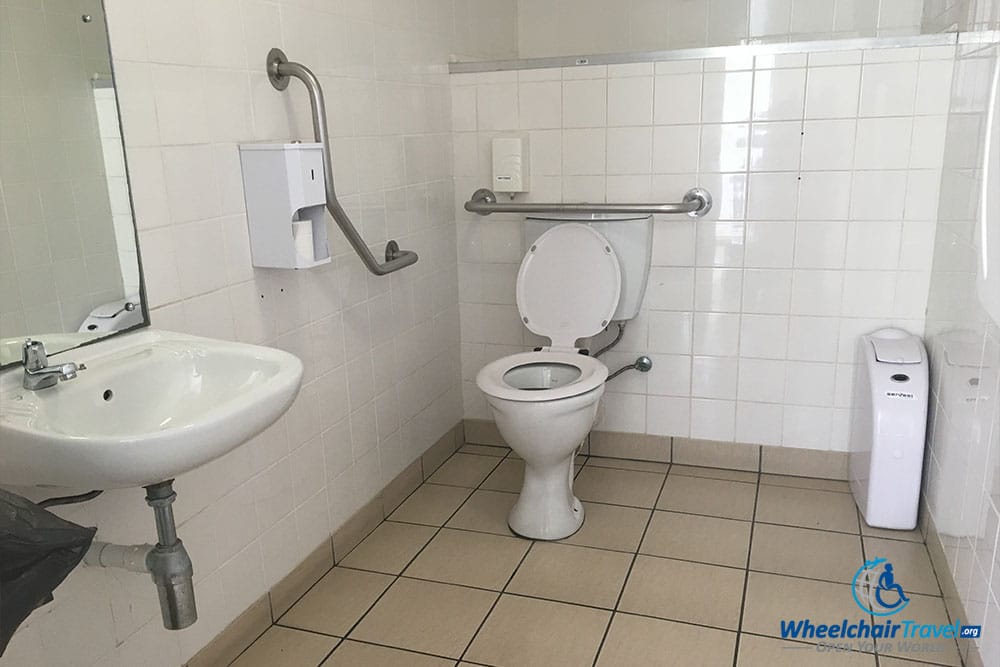
A ramp is attached to the wash room facilities, which are connected via a deck to the shop selling food & beverages. The wheelchair accessible bathroom is private, and can accommodate the wheelchair user and his/her assistant or carer. There is space to park a wheelchair next to the toilet, and grab bars to aid in a safe transfer.
After the pit stop, you’ll board the bus and ride around for another 20-25 minutes to tour more of the island’s interior region. Tourists are let off for the second and final time at the maximum security prison, which is only about 200 yards beyond the main entrance gate.
Touring the Prison on Robben Island
Once you hop of the bus, you’ll meet your new guide for the prison portion of the tour. Each of these guides are former political prisoners themselves, who served time on Robben Island. They are an invaluable resource and speak with the authority of personal experience and memory.
After a brief introduction, you’ll walk/roll for about five minutes—winding through corridors, hallways and outdoor courtyards, until you reach a dormitory where political prisoners were housed. Visitors enter and take a seat in the dormitory, where they’ll listen to a presentation of about 20 minutes detailing the day-to-day lives of prisoners on Robben Island.
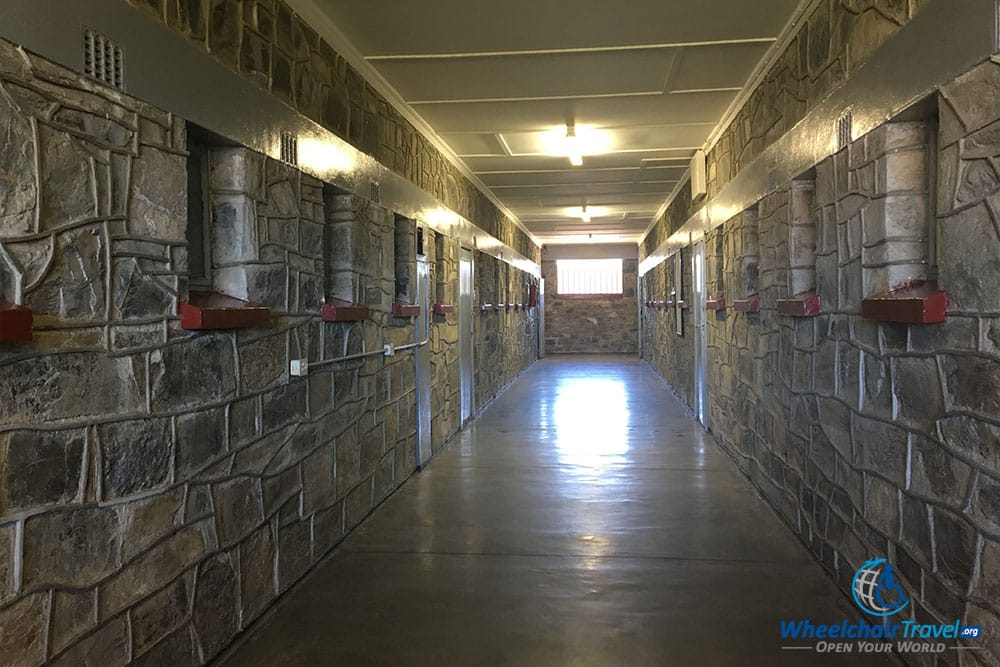
For power wheelchair users, there is a small problem. The threshold to the dormitory is a step of 4 to 5 inches. While many offered to lift my chair, I did not want to risk damaging it and declined. At the time, it was less than a month old, so taking risks was not in the cards. Instead, I listened to the presentation from the hallway outside (pictured above).
I have sent an e-mail to the address listed on the Robben Island website, offering to donate the money to build a small ramp, so that future visitors using wheelchairs are not excluded. It is amazing how disabling 4 inches can be, but the fix is easy. I will be happy to contribute to keep the history of Robben Island alive in the hearts of all, regardless of physical ability. I hope they will respond and accept my contribution!
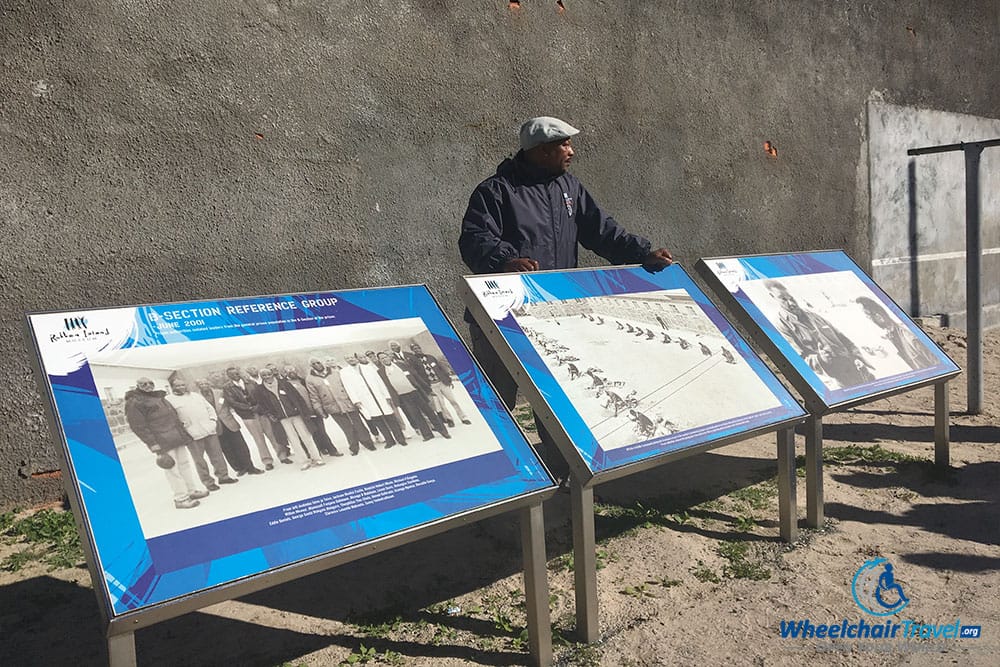
In an interior courtyard, just steps away from Nelson Mandela’s cell, my tour guide (whose name I regrettably do not remember) discussed public perception of the prison. In the photo above, he stood behind an image that was released to the public by the apartheid government. The image shows two lines of prisoners—one being political prisoners, seen repairing torn clothes; the other bring criminal offenders, seen crushing rocks with hammers.
This image, of course, was a PR stunt—a lie. Nelson Mandela did not spend his time on Robben Island as a seamstress. Instead, he worked long hours in the quarry, conducting hard labor.
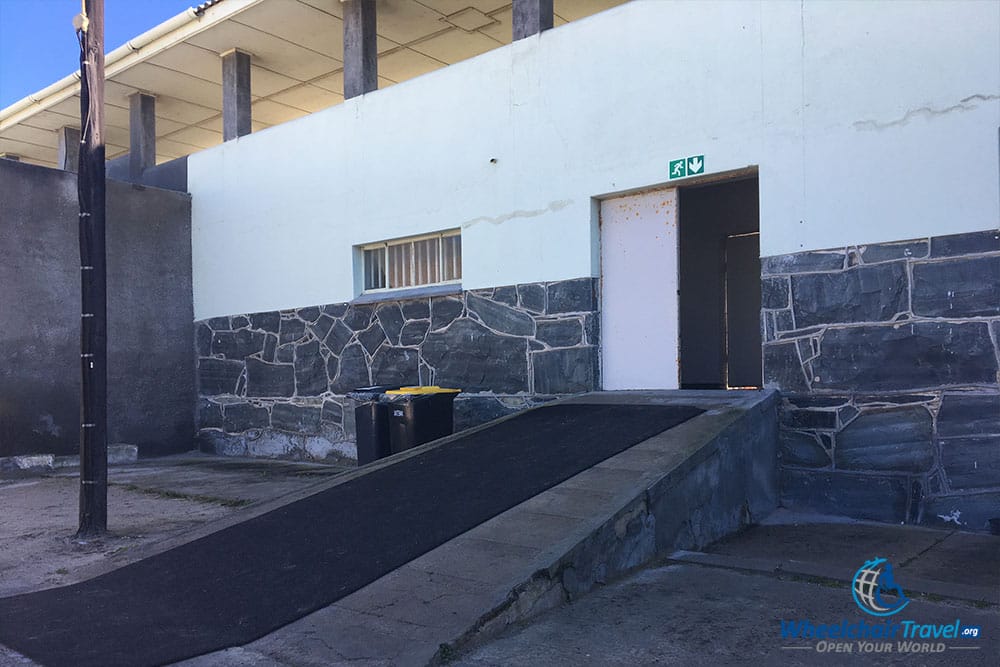
After this last discussion in the courtyard, we returned inside to see Nelson Mandela’s prison cell. Wheelchair access was via the ramp pictured above, which was quite steep. Manual wheelchair users might need a push up.
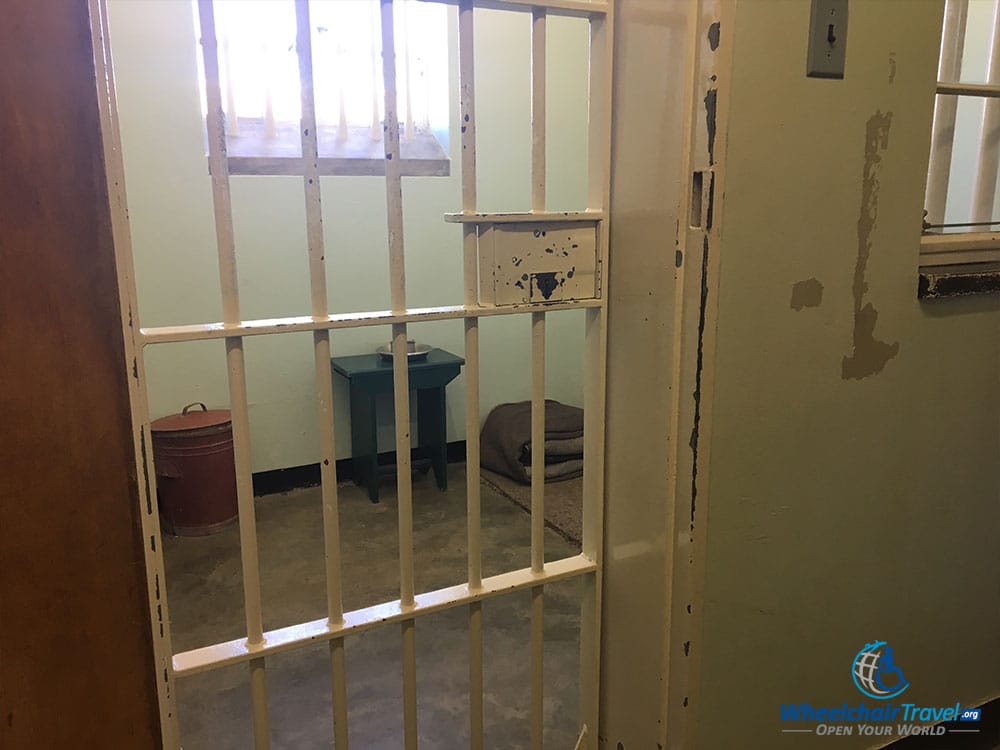
Nelson Mandela was held in a small cell, though it was not as small as I anticipated. There was no bed, only a blanket and carpet to be laid out on the cement floor. A small table and bucket for using the bathroom were the only other “amenities” afforded to him. When you look at Nelson Mandela’s prison cell and consider spending 18 years there, as an innocent man, you realize how horrible human beings can be to one another.
The world is thankful that Mandela was freed. That he was given a reprieve from injustice. But I am thankful that he saw freedom as not just as a casting off of chains, but also as a call to “live in a way that respects and enhances the freedom of others.”
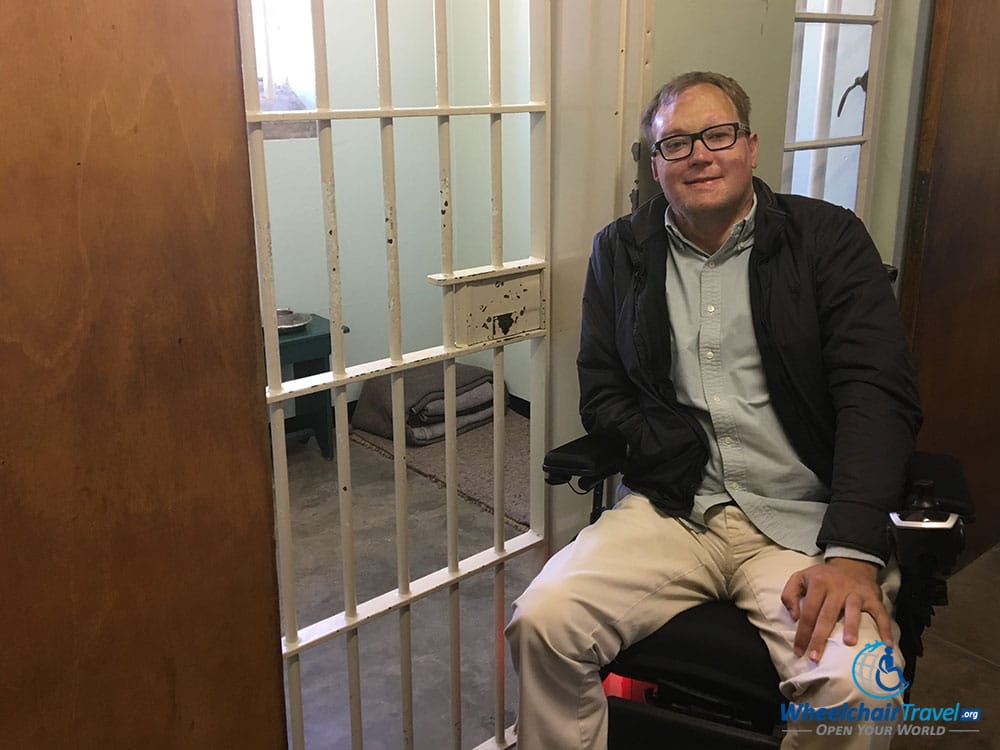
Just to prove I was there, I took a picture. It was a moving experience that I will remember well into the future. I suspect you will feel the same way, when you visit this site of immense history and heritage. Having reached the end of this post, I would typically share some final thoughts, but I have said enough.
Be sure to order your copy of Nelson Mandela’s autobiography.
Share the good news of what’s possible in a wheelchair with your friends on Pinterest!
